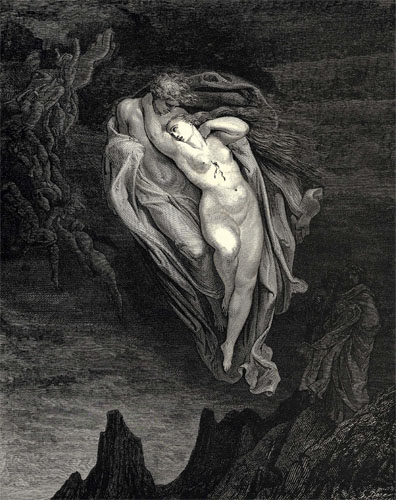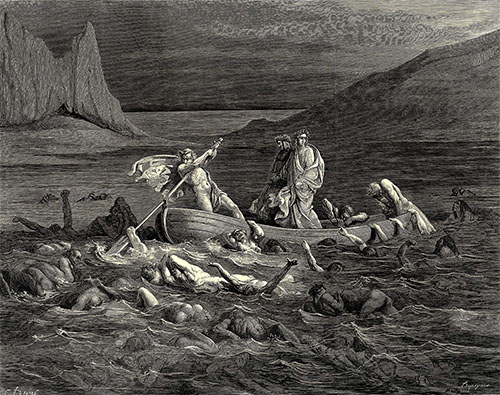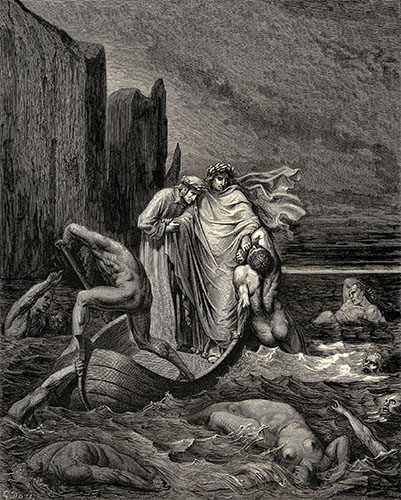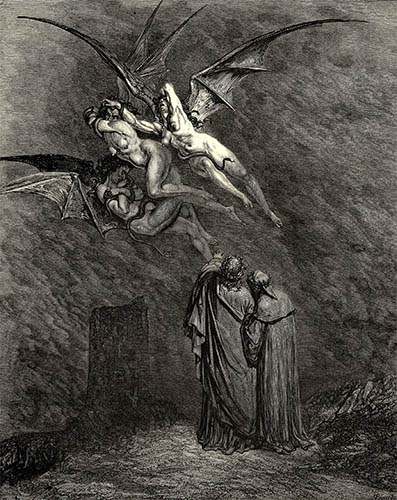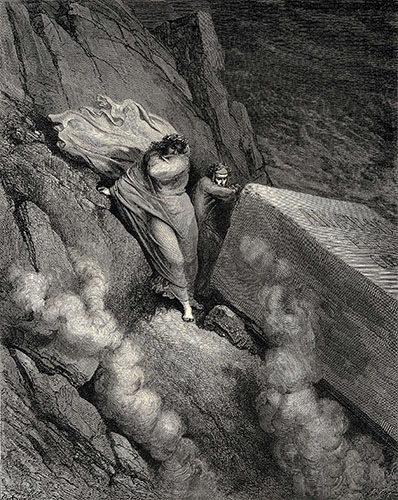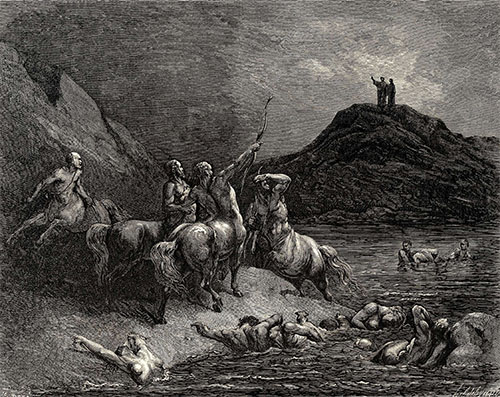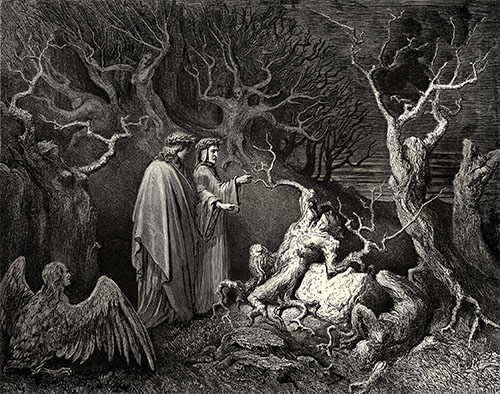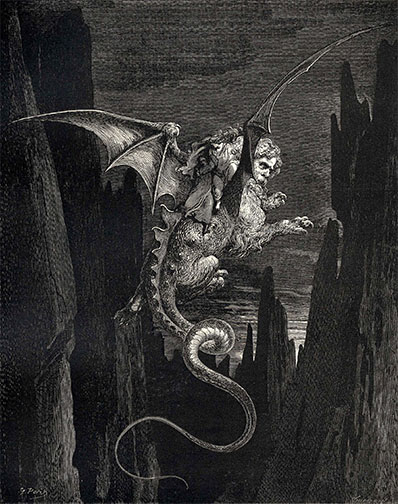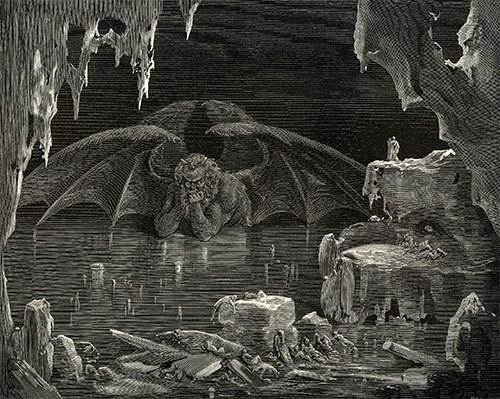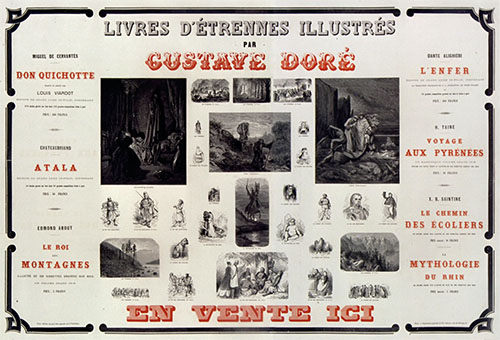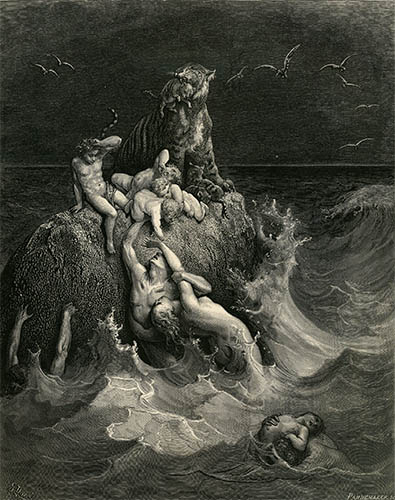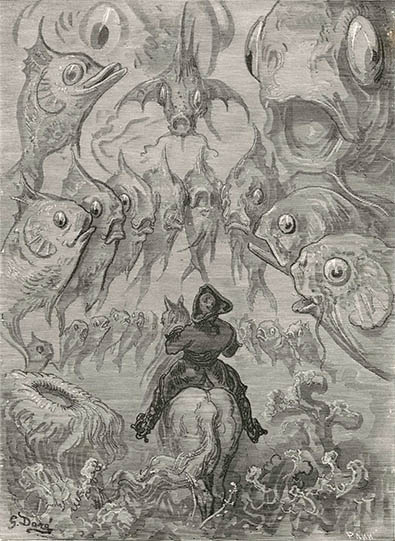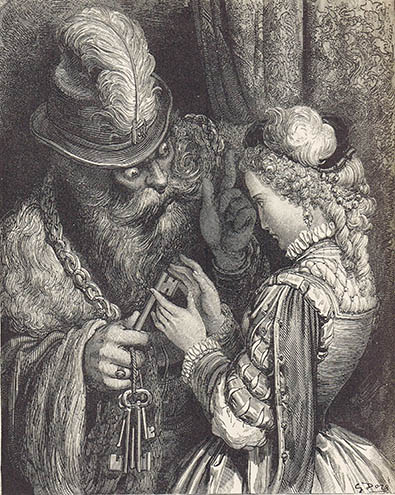101
L’Enfer de Dante Alighieri
Gustave Doré
Louis Auguste Gustave Doré was born 6 Jan 1832 in Strasburg, the second of three sons of the civil engineer Pierre and Alexandrine (Pluchart) Doré. As a child he showed a preternatural talent for art. By age five he was drawing, by eight illustrating books and by 12 etching his own lithographic plates - all without any formal training.2
The story goes that at age 15, while with his family in Paris, he barged into the office of the publisher Auber and Philipon to show his work. Charles Philipon was so stunned that he refused to let the young Doré leave before his father could be tracked down and a contract signed. Gustave moved in with Philpon and began working as a caricaturist for Philipon’s new Journal pour Rire.
Gustave’s father died of pleurisy when he was 17 and his mother pressed him to find even greater commercial success (either to support the family or to aid in her social climbing, reports differ).3 After some 2000 caricatures for Philipon Doré began to illustrate books. His first success was with Rabelais in 1854 and Balzac in 1855.4
As early as 1855 Doré envisioned a “chefs-d’oeuvre de la littérature,” an illustrated series of classics including Homer, Ossian, Byron, Goethe, Racine, and Corneille. His first title was Dante’s Inferno from his Devine Comedy. When Doré suggested the idea of an oversized folio of the work to his publisher Hatchette they refused it. Although Dante was popular in 19th century France - it wasn’t that popular. Undeterred, Doré financed and published the edition himself, with Hatchette acting simply as the printer. Hatchette even suggested printing only a 100 copies to save on binding cost. When the original edition sold out within two weeks Louis Hatchette sent Doré the infamous telegram: “Success! Come quickly! I am an ass!”5
Canto 5, lines 72–74
Charon and the river Acheron. Canto 8, lines 27–29
Canto 8, lines 39–41
Megaera, Alecto and Tisiphone. Canto 9, line 46
Doré’s woodcuts - a combination of Raphaelite nudes, gothic scenery and medieval bestiaries - perfectly captured the artistic sensibilities of Victorian France. As one critic wrote in 1861: “we are inclined to believe that the conception and the interpretation come from the same source, that Dante and Gustave Doré are communicating by occult and solemn conversations the secret of this Hell plowed by their souls, traveled, explored by them in every sense.”
Canto 11, line 67
Minos. Canto 12, lines 11–14
Canto 12, lines 38–39
Canto 13, line 34
Canto 17, line 117
Lucifer, trapped in the 9th circle. Canto 34, lines 20–21
With his reputation now established, Doré would began a remarkably prolific career as a book illustrator. Major highlights included Edmond About’s Le Roi des Montagnes (1861), Saintine’s Les Mythologies du Rhin (1862), Gastineau’s La Chasse au Lion et à la Panthère and Cervante’s Don Quixote de la Mancha (1863), La Sainte Bible and Milton’s Paradise Lost (1866), Les Contes de Perrault (1867) and Coleridge’s Le Chanson du Vieux Marin (1870).
Advertising poster, 1865. BNF Gallica
The Deluge – Doré Bible, 1866. Wikimedia
Don Quixote, 1863. ASIFA Archive
Bluebeard – Les Contes de Perrault, 1867. Frank Zumbach
Doré, supervising a team of up to 40 engravers, illustrated more than 200 books and produced more than 10,000 engravings during his life. He also one of the first artists to fully embrace the electrotype to reproduce his woodblocks, resulting in a dizzying array of editions. The Inferno was published in more than 200 editions. Don Quixote in more than 300 editions and the Doré Bible in more than 700 editions. Van Gogh called him “an artist of the people.”
Doré died of a heart attack on 18 Jan 1883, just two years after his mothers death. Although he never received the recognition for his paintings and sculpture he hoped for, his book illustrations continue to be influential to this day. Not only did he define our modern vision of Dante or Cervante but horror and fantasy illustration in general. His work has influenced artists as diverse as Heinrich Kley, Max Ernst, Walt Disney, even the director David Lean.
1. All of the Inferno images are from the Art Renewal Center.
2. For wordy late-Victorian biographies see: Roosevelt, Blanche. The Life and Reminiscences of Gustave Doré. New York: Cassell & Co, 1885 ( Google Books). or Blanchard, Jerrold. Life of Gustave Doré. London: W. H. Allen & Co., 1891.
3. After her husbands death Alexandrine purchased a large house at Rue St Doninique. Gustave set up his studio in his mothers bedroom (the blue room) and had his own bedroom opposite the foot of her bed. He would work in her bedroom and sleep in the room next to her much of his life. To suggest that his attachment to his mother was unhealthy would be an understatement. After her death he stated in a letter "Since I was born I had never ceased to live at the side of that tenderest, most devoted, and generous of mothers" Even more disturbing, when asked about his bachelorhood he said he "was married to her [Alexandrine] and his art." Having said all that, however, he did manage to have an affair with Sarah Bernhardt. Here is a Doré portrait of Sarah:
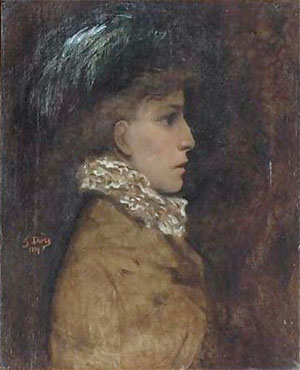
4. Jacob, P. L., Barré, Louis. Oeuvres de François Rabelais. Paris: J. Bry. Ainé, 1854. The entire text is available online at BNF Gallica BNF Gallica. De Balzac. Les Contres Drolatiques. Paris: ez bureaux de la Société générale de librairie, 1855. Again available at BNF Gallica.
5. Alighieri, Dante. L’Enfer de Dante Alighieri, avec les dessins de Gustave Doré. Traduction française de Pier Angelo Fiorentino, accompagnée du texte italien. Paris: L. Hachette, 1862. (BNF Gallica). The original 196 pp. oversized folio included 76 engravings and sold for 100 fr (6-7x the price of a typical book).
30 Aug 2011 ‧ Illustration

